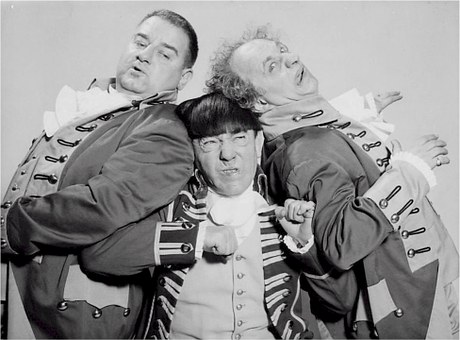
In a society where people have the right to voice their opinions, a leader’s role is often to find consensus. On the occasion when everyone agrees, it’s tempting to sigh in relief and start happy hour a little early. If this is the case, fight the temptation; your lack of conflict is a drawback.
Successful organizations need dissent. That’s why I want a little Three Stooges on my team. Who better demonstrates the bickering, questioning, and debating that a healthy team requires? If you look beyond the physical attacks, Larry, Moe, and Curly/Shemp hold each other accountable. They avoid groupthink, the faulty decision making created by group pressures, and analyze all sides of a problem before settling on a solution. Their plans don't typically work out, but imagine how prosperous they’d be with 20 more IQ points.
To encourage the dissension necessary for a high performing team, a recent paper in The Proceedings of The Royal Society A investigated the idea of paradox of unanimity. When groups of people unanimously agree, it’s assumed they cannot all be wrong; after all, what are the odds that the masses will find total accord? The paradox of unanimity states that this confidence in unity is ill-founded.
Overwhelming agreement without a dissenting opinion actually weakens credibility and points to a systemic error in the system. The researchers demonstrated this paradox in a police line-up where witnesses were tasked with identifying a suspect. The study found that as the number of unanimously agreeing witnesses increased, the chance of them being correct decreased until it was no better than a random guess.
As with most ‘paradoxes,' it is not that our intuition is necessarily bad, but that our intuition has been badly informed. In these cases, we are surprised because we simply aren't generally aware that identification rates by witnesses are in fact so poor.— Derek Abbott, probability expert from the University of Adelaide
In some cases, large, unanimous agreement is expected, but only when there is little room for bias. For instance, when witnesses must identify an apple in a line-up of bananas, it is nearly impossible to be incorrect. However, a criminal line-up is more complicated than identifying pieces of fruit. Misidentification rates are as high as 48% especially when witnesses only briefly view the perpetrator.
The paradox of unanimity is common in the workplace, as well, and we may be unintentionally propagating it. In today’s work environment, there’s a popular notion that decisions should be unanimous. I’ve sat through many meetings where a bold idea is whittled away to gain consensus. Since the company message states that dissenting voices are welcome, the meeting tackles each aspect of the plan point by point. When someone disagrees, the team has to convince the dissenters otherwise or scrap that section of the plan. The end product is often inferior to what you started with and lacks the intended impact, BUT everyone is in agreement.
If you find yourself on the endless search for agreement, stop. The leadership role involves making tough decisions. Survey those on your team and then create an educated resolution. Not everyone will agree, and nor should they—if everyone agrees with every decision you make, your decisions are too broad, are inconsequential, or you’re pandering.
A culture of consent is a culture of either complacency, fear of change, or a lack of engagement, so instill some Stooge into your team. Swing your proverbial frying pan to encourage discourse. Poke others in their metaphoric eyes to extract feedback from the meek. Throw your oratorical cream pies to find areas of debate. And allegorically slap the team into expressing their sincere opinions without fear of retribution or judgment.





